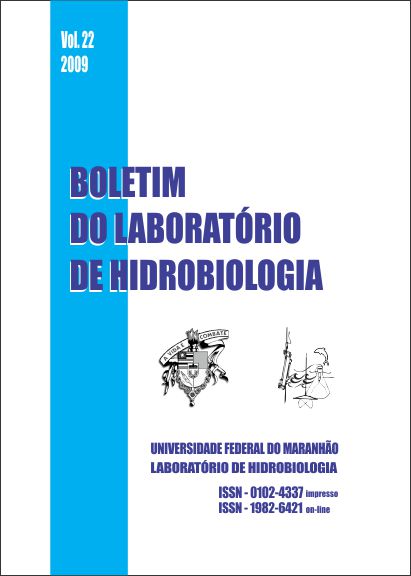RELAÇÕES ECOLÓGICAS ENTRE A FAUNA ICTIOLÓGICA E A VEGETAÇÃO CILIAR DA REGIÃO LACUSTRE DO BAIXO PINDARÉ NA BAIXADA MARANHENSE E SUAS IMPLICAÇÕES NA SUSTENTABILIDADE DA PESCA REGIONAL
DOI:
https://doi.org/10.18764/Abstract
A região lacustre de Penalva, na Baixada Maranhense, é formada pelos lagos Cajari, Capivari, da Lontra e Formoso, que dão base em seus entornos, a uma diversificada vegetação ciliar. Esses ambientes, sujeitos às influências de inundações sazonais, propiciam uma variedade de habitats para abrigo, reprodução e alimentação de peixes. Algumas espécies de peixes ao se alimentarem de frutos e sementes das espécies vegetais ciliares ajudam no processo de dispersão das sementes, contribuindo para o sucesso reprodutivo das plantas. Esta pesquisa teve como objetivo estudar a relação da fauna ictiológica da região lacustre de Penalva com a vegetação ciliar e suas implicações na sustentabilidade da pesca regional. Mais especificamente, analisar a relação entre as diferentes espécies vegetais e o período reprodutivo, alimentação e abrigo dos peixes, investigando quais as espécies de peixes dependentes da vegetação ciliar e quais as espécies dispersoras de sementes. A metodologia incluiu, em uma primeira fase, entrevistas com pescadores informantes-chaves, utilizando-se questionários semi-estruturados para resgate e uso do conhecimento tradicional sobre peixes e vegetação. Em uma segunda fase, foram realizadas coletas mensais de peixes nos lagos Cajari e Capivari no período de abril de 2007 a junho de 2008, seguidas de análises laboratoriais. Os resultados mostraram que os pescadores possuem conhecimentos apurados sobre a relação da ictiofauna e a vegetação ciliar regional e evidenciaram a dependência entre peixes e plantas. Neste estudo foram identificadas onze espécies de peixes dispersoras de sementes de onze espécies vegetais ciliares. Na estação chuvosa, quando grandes áreas de vegetação encontram-se inundadas, foi registrado o maior número de peixes com estômagos cheios e o maior número de machos e fêmeas em estágio de maturação confirmando a importância da mata ciliar para a ictiofauna.
Palavras-chave: Matas ciliares, ictiofauna, Penalva, relações ecológicas, sustentabilidade da pesca.
Abstract
Ecological relations between the ichthyologic fauna and the ciliary vegetation of the lacustrine area of Low Pindaré River in the Baixada Maranhense Region and their implications on the sustainability of regional fishing.
The lacustrine area of Penalva, in the Baixada Maranhense region, is formed by the lakes Cajari, Capivari, Lontra and Formoso, which encompass a diversified ciliary vegetation. Those environments, subject to the influence of seasonal floods, provide a variety of habitats for shelter, reproduction and feeding of fish species. Some of the fish species, as they feed from fruits and seeds from ciliary plant species they help in the process of seed dispersion, contributing to the reproductive success of the plants. This research aimed at studying the relationship between the ichthyologic fauna of the lacustrine area of Penalva and the ciliary vegetation and its implications in the sustainability of the regional fishing. More specifically, to analyze the relationship among the different plant species and the reproductive period, feeding habits and shelter of the fish species, investigating which species are dependent on the ciliary vegetation and which species function as seed dispersers. The methodology included, in a first phase, interviews with fishermen (key informants), by using semi-structured questionnaires, to record the traditional knowledge on fish and vegetation. In a second phase, monthly collections of fish specimens from the lakes Cajari and Capivari were carried out in the period April, 2007 to June, 2008; following the collections, the specimens were taken to laboratory analyses. The results showed that fishermen possess a vast knowledge on the relationship between the ichthyofauna and the regional ciliary vegetation, making clear the dependence between fish and plants. In this study eleven fish species were identified as seed dispersers of eleven ciliary plant species. In the rainy season, when extensive vegetation areas are flooded, the biggest number of fish specimens was recorded with full stomachs, as well as the biggest number of males and females in the maturation phase, confirming the importance of the ciliary forests for the ichthyofauna
Key words: Ciliary forests, , Ecological Relationships, Ichthyofauna, Penalva, Sustainability of Fishing.
Downloads
Riferimenti bibliografici
ARAUJO, N. A. 2005. Avaliação sócio-econômica da pesca artesanal e do potencial aquícola na região lacustre de Penalva, Área de Proteção Ambiental da Baixada Maranhense. São Luís. 82 pp. Monografia apresentada ao curso de Ciências Aquáticas da Universidade Federal do Maranhão - UFMA.
AYRES, J. M. 1995. As matas de várzea de Mamirauá. Brasília, DF: CNPq, Sociedade Civil Mamirauá, 123p.
BRASIL. Lei nº 4.771, de 15 de setembro de 1965. Institui o novo Código Florestal.
CORREIA, J. de O. 2006. Sustentabilidade dos sistemas agro-extrativos de produção da região lacustre de Penalva - MA, na Área de Proteção Ambiental da Baixada Maranhense. São Luís. 99 pp. Dissertação de Mestrado apresentada ao curso de pós-graduação em Sustentabilidade de Ecossistemas da Universidade Federal do Maranhão - UFMA.
HYSLOP, E. J. 1980. Stomach contents analysis - a review of methods and their application. J.Fish Biol., London, 17:411- 429.
MAIA, L. A. & CHALCO, F. P. 2002. Produção de frutos de espécies da floresta de várzea da Amazônia Central importantes na alimentação de peixes. Acta Amazônica, 32(1):45 - 54.
PILATI, R., ANDRIAN, I. F., CARNEIRO, J. W. P. 1999. Desempenho germinativo de sementes de Cecropia pachystachya (Cecopiaceae), recuperadas do trato digestório de Doradidae, Pterodoras granulosus (Valenciennes,1833), da Planície de Inundação do Alto rio Paraná. Interciência, 24(6).
REYS, P. et al. Fenologia reprodutiva e disponibilidade de frutos de espécies árboreas em mata ciliar no rio Formoso, Mato Grosso do Sul. Biota Neotrópica, 5(2). Disponível em: http://www.biotaneotropica.org.br. Acesso em:22/05/2007






